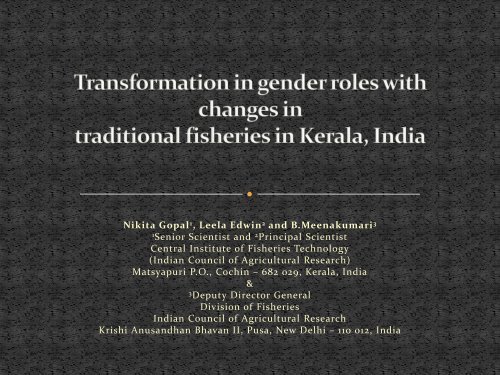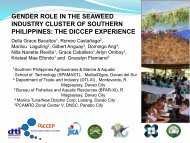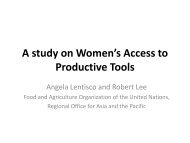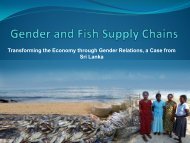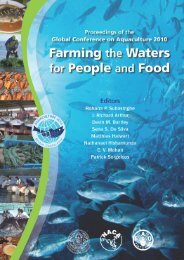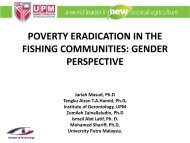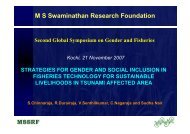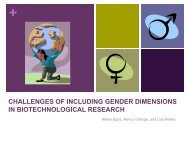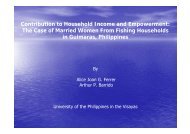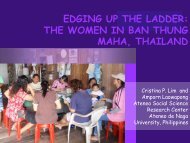Nikita Gopal - GENDER IN AQUACULTURE AND FISHERIES
Nikita Gopal - GENDER IN AQUACULTURE AND FISHERIES
Nikita Gopal - GENDER IN AQUACULTURE AND FISHERIES
Create successful ePaper yourself
Turn your PDF publications into a flip-book with our unique Google optimized e-Paper software.
<strong>Nikita</strong> <strong>Gopal</strong> 1 , Leela Edwin 2 and B.Meenakumari 3<br />
1<br />
Senior Scientist and 2 Principal Scientist<br />
Central Institute of Fisheries Technology<br />
(Indian Council of Agricultural Research)<br />
Matsyapuri P.O., Cochin – 682 029, Kerala, India<br />
&<br />
3<br />
Deputy Director General<br />
Division of Fisheries<br />
Indian Council of Agricultural Research<br />
Krishi Anusandhan Bhavan II, Pusa, New Delhi – 110 012, India
• Universal premise -<br />
• Any change has an impact<br />
• Could be positive , neutral or negative<br />
• In food production systems changes can be related to:<br />
• Technology, policy, socio-political, legal etc.<br />
Change Positive Negative<br />
Mechanization<br />
improving food production<br />
bringing in more area under<br />
cultivation<br />
fishers going farther and<br />
deeper for more fish<br />
exclusion (not<br />
necessarily intentional)<br />
small farmers<br />
women
Framework<br />
Components
An indicative framework<br />
Fisheries &<br />
Aquaculture<br />
• Ring Seine Pelagic<br />
Fishery<br />
• Clam Fishery<br />
Technology<br />
Development<br />
Stake Net<br />
Fishery<br />
Policy<br />
Forumaltion<br />
Environmental<br />
changes<br />
Development<br />
issues<br />
Direct Impact<br />
Indirect Impact<br />
Income &<br />
Employment<br />
Livelihhod<br />
changes/shifts<br />
Policy for<br />
mitigating<br />
livelihood<br />
shifts/changes<br />
FAO Fisheries and Aquaculture Report No. 998 FIRA/R998 (En) - Report of the FAO WORKSHOP ON FUTURE DIRECTIONS<br />
FOR <strong>GENDER</strong> <strong>IN</strong> <strong>AQUACULTURE</strong> <strong>AND</strong> <strong>FISHERIES</strong> ACTION, RESEARCH <strong>AND</strong> DEVELOPMENT , Shanghai, China, 23–24 April<br />
2011
Activity profile<br />
Component<br />
Who does what<br />
Description<br />
When<br />
Where<br />
Resources, access & control<br />
What resources are available<br />
Who has access to what resource<br />
Who has overall control over the resources<br />
Institutional constraints &<br />
opportunities<br />
Policy, law<br />
Source: Mainstreaming Gender and Development in the World Bank: Progress & Recommendations,<br />
Caroline O. N. Moser, Annika Tornquist, Bernice van Bronkhorst, 1999, The World Bank
• Study area<br />
• South west India – state of Kerala<br />
• Kerala has 10% percent of the country's coastline<br />
• Contributes 20% to India’s marine fish production<br />
• 40% to seafood exports.
• Continental shelf of about<br />
40,000 km 2 –<br />
• one of the most<br />
productive waters.<br />
• 223 fishing villages<br />
• 11.43 lakh persons depend<br />
on the marine resources for<br />
their livelihood<br />
• 2.63 lakh active fishermen
• Various fishing fleet<br />
• Mechanised fishing fleet<br />
• Trawlers<br />
• Gill netters<br />
• Long liners<br />
• Purse seiners<br />
• Motorised traditional fleet<br />
• IBM (in board motor) ring seines<br />
• OBM (out board motor) ring<br />
seines<br />
• Mini trawlers<br />
• Gill netters, hooks and liners, boat<br />
seiners and shore seiners.<br />
• Non-motorised traditional fleet
R<strong>IN</strong>G SE<strong>IN</strong>E<br />
FISHERY<br />
• Seen along in the<br />
entire coast of Kerala<br />
except for the<br />
southern tip<br />
• Plays a significant<br />
role in the marine<br />
landings in Kerala<br />
contributing 51.6%.<br />
• Out of total pelagics,<br />
98.8% of oil sardine,<br />
71% of lesser sardine,<br />
56% of mackerel and<br />
42.6% of white baits<br />
landings contributed<br />
from ring seiners.
• Craft a combination of two vessels<br />
• Main vessel which is a large inboard mechanized vessel fitted with a<br />
winch<br />
• Smaller skiff (also called carrier) with an outboard engine.<br />
• Main vessel is of an LOA of 65’ to 80’ while the skiff is about<br />
40’ to 55’
• Steel IBM unit (craft and gear) between Rs 50 lakh to 60<br />
lakh (USD 90,000 – 100,000)<br />
• vessel, including engine, costing upto Rs. 40 lakh (USD 73,000)<br />
• gear Rs. 15- 20 lakh (USD 27,000 to 36,000)<br />
• Uncontrolled growth of craft and gear size are the main<br />
reasons for the huge investment<br />
• From wood to steel<br />
• Powerful inboard engines<br />
• Carrier skiffs<br />
• Mostly wooden crafts<br />
• Cost upto 4 lakh (USD 7300)
Small scale<br />
Beach landing<br />
(in early sixties)<br />
Capital Intensive<br />
Labour intensive<br />
Harbour based<br />
Mesh size : 18-22 mm<br />
length : 300 m to 1200 m<br />
depth : 50 m to 110 m<br />
craft: 70-76 feet<br />
crew size : 35-45<br />
operated with inboard engine<br />
• Community - Latin Catholic
• The beach landing facilitated the active participation of<br />
women, who took over the post harvest activities like<br />
sorting the catches and further marketing or processing.
• With the landings shifting to the harbours and becoming linked to<br />
price incentives of the market, women have slowly been marginalised.<br />
• Women engaged in marketing still frequent harbours, for purchase of<br />
fish, but the post harvest activities, like handling the catch etc. have<br />
been taken over by organised male labour.
STAKE NET<br />
FISHERY<br />
• Seen in the<br />
backwaters of the<br />
state<br />
• Fishers belonging<br />
to the Dheevara<br />
community<br />
operate this<br />
• Traditional rights
• Generally operated by the<br />
Dheevara caste which has<br />
traditional rights over padus<br />
or designated stake net<br />
fishing areas/ regions in the<br />
backwaters.<br />
• The stake net, known as<br />
‘Oonni vala' in the Malayalam<br />
language, is very common in<br />
the backwaters of Kerala.<br />
• They constitute a very<br />
important gear used for<br />
backwater fishing in the<br />
state.
The average investments in the gear is<br />
approx Rs. 10000 (USD 180) and each stake<br />
costs around Rs. 5000 (USD 90)<br />
• The stake conical bag net set in<br />
streams and tidal waters to<br />
small fish and prawns that are<br />
swept along its course and the<br />
fishing principle is filtering, the<br />
gear non-selective.<br />
• The fishery is based on the<br />
lunar periodicity.<br />
• The net is tied in between stakes<br />
at the beginning of the low tide<br />
and hauled just before the low<br />
tide ends.
• Women not involved in harvesting operations.<br />
• Come into the picture only after the catch is landed, sorting<br />
the catch and later marketing them.<br />
• On an average they spend 4-5 hours sorting the catch and then<br />
the marketing is carried out. The marketing may be carried<br />
out both by men and women, depending on the trading<br />
arrangements.
• The stake net fishery is facing increasing competition from<br />
other fishery as well as commercial interests.<br />
• The catches in general have been declining and there is<br />
increasing pressure to abandon what had been a way of life for<br />
generations.<br />
• In this changing scenario, the need to protect the padus from<br />
passing on to another family is pre-empted by discontinuing<br />
the practice of women getting a share in the padus (in the form of<br />
dowry).<br />
• Inheritance has been through the male line and it generally<br />
passes from father to son.
Social changes<br />
• Fragmentation of families, fragmentation of ownership<br />
• Earlier girl children received as dowry. Now discontinued,<br />
owing mainly to economic considerations.<br />
• Single mothers/ widows are taking over the stake nets of their<br />
husbands and leasing out the same as there is no other means<br />
of livelihood.<br />
• Ritualistic customs still prevent them handling / touching the<br />
net during certain times.<br />
Legal issues<br />
• The State no longer collecting taxes, so loss of legal rights.<br />
• Ownership transfer has not taken place for the past two<br />
generations.<br />
• May have social implications.
CLAM FISHERY<br />
• Seen in the<br />
backwaters<br />
• Family based<br />
activity<br />
• Targeting<br />
sedentary animals<br />
like clams
• Very localized fishery.<br />
• This fishery evolved basically to<br />
cater to the lime industry.<br />
• The shells were more sought after<br />
than the clam meat.<br />
• Here again the fishermen are from<br />
the Dheevara caste.<br />
• The fishing which was done by<br />
diving and hand picking was an<br />
activity women had been actively<br />
engaged in (along with men).<br />
• The introduction of small canoes,<br />
which have over time become<br />
motorised, and the scoop nets have<br />
made the activity male centric and<br />
now women are rarely seen in<br />
harvesting.<br />
Average investments range from<br />
Rs. 40000 to 50000 (USD 730 to 910)
• Women are now restricted to processing and shucking of<br />
the clam meat and further marketing of the meat.
Producers<br />
(Clam picker cum<br />
processor)<br />
Wholesaler<br />
Retailer
• Women have been displaced out of several activities they<br />
have been involved in……<br />
• In the ring seine sector, traditional post harvest activities no<br />
longer exclusive to women - drudgery has increased as they<br />
have to travel longer distances to reach harbours (even<br />
fishermen have to travel long distances to begin the fishing<br />
trips), wait for the catch to be landed, jostle to get a share and<br />
in general spend longer hours in procuring and marketing the<br />
catch.<br />
• Social, economic and legal issues affecting the stake net<br />
fishery; women still active in post harvest sorting (again<br />
drudgery high).<br />
• In clam fishery, women are no longer involved in harvesting;<br />
continue to process the harvested clam and are also involved<br />
in marketing.
Thank you<br />
“Fishing is a... discipline in the equality of men ---------------for all men are equal before fish"<br />
- Herbert Hoover


